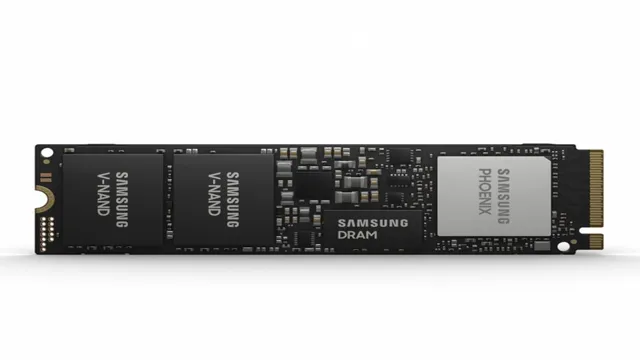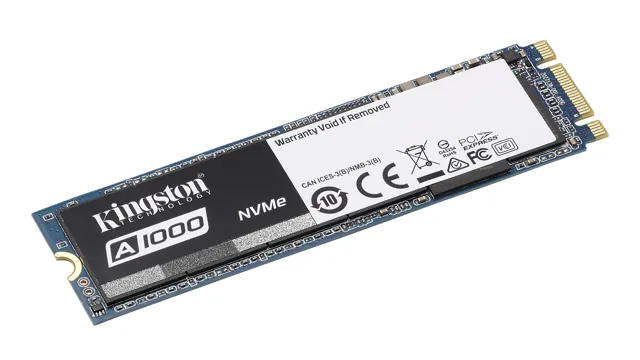Picture this: you finally update your computer with the latest hardware and you’re excited to experience lightning-fast speeds. You power it up and..
.nothing. Despite having the latest components, your computer feels sluggish.
What could be the problem? Chances are, you’re not using an M.2 NVMe drive. M.
2 NVMe drives are the latest and greatest in storage technology, designed to maximize speed and performance. They may be small in size, but don’t let that fool you – they pack a punch when it comes to read and write speeds. In fact, the fastest M.
2 NVMe drives can read and write at speeds of up to 7,000 MB/s and 5,000 MB/s, respectively. That’s around six times faster than the average SATA SSD. So why doesn’t everyone have an M.
2 NVMe drive in their computer? Well, it’s not always necessary. If you’re using your computer for basic tasks like web browsing and word processing, you’ll probably be fine with a regular SATA SSD. But if you’re a gamer, graphic designer, or video editor, an M.
What is M.2 NVMe?
M.2 NVMe is a type of solid-state drive (SSD) that is commonly used in today’s modern computers. It is a newer standard that replaces the older mSATA and offers faster transfer speeds and lower latency.
The M.2 NVMe utilizes the NVMe protocol, which is specifically designed to handle the high-speed transfer of data between storage devices and the system’s processor. This means that M.
2 NVMe SSDs can read and write data at speeds exceeding 3GB/s, significantly faster than traditional mechanical hard drives. Unlike other traditional storage drives, M.2 NVMe SSDs are much smaller and take up less space in your computer.
It is easy to install and typically requires no extra cables. So, if you’re in the market to upgrade your computer’s storage, M.2 NVMe might be a great option for you to consider!
Understanding the Technology
M.2 NVMe refers to a type of solid-state drive (SSD) technology that is used in modern laptops and desktops. The M.
2 form factor is a small, thin, and flat storage device that can be easily installed in a computer or laptop motherboard. The NVMe (Non-Volatile Memory Express) is a protocol that allows SSDs to communicate with the computer’s processor more efficiently than previous generations of SSDs. This technology uses a PCI Express (PCIe) interface that can transfer data at a faster rate than traditional SATA SSDs.
The benefits of using an M.2 NVMe SSD are clear. The faster data transfer rates provide faster boot times, quicker application load times, and improved gaming performance.
Additionally, an M.2 NVMe SSD takes up less space in your computer or laptop, providing more room for other components or features. Comparatively, it is faster than a traditional hard drive and SATA SSD.
It is essential to note that NVMe SSDs are compatible only with specific motherboards that have an M.2 PCIe slot. Still, some laptops lack an M.
2 SSD slot or don’t have a PCIe slot to support the technology. Investing in an M.2 NVMe SSD could undoubtedly make a significant difference in your computer’s performance, particularly if you use your computer for resource-intensive tasks or operations.

Why Choose M.2 NVMe?
M.2 NVMe is a next-generation storage solution that has taken the tech world by storm. It’s a small, yet mighty, technology that offers lightning-fast read and write speeds, which make it the go-to choice for gamers, content creators, and professionals who demand the best.
M.2 NVMe is different from traditional storage solutions like hard drives and SATA-based SSDs. It uses a faster and more efficient interface – PCIe – which provides higher bandwidth and lower latency.
This translates into faster app load times, better system responsiveness, and quicker file transfers. So, why choose M.2 NVMe? Simply put, it’s the fastest, most efficient, and most reliable storage option available today.
Whether you’re a gamer looking for a competitive edge or a content creator seeking maximum productivity, M.2 NVMe is the way to go. So, if you’re in the market for top-tier storage, be sure to give M.
2 NVMe a closer look.
Boosting Performance
If you’re looking for a way to boost your computer’s performance, one of the best options is to upgrade to an M.2 NVMe SSD. This type of drive is faster than traditional SATA SSDs, which means that your computer can boot up faster, launch programs more quickly, and transfer files at lightning speeds.
M.2 NVMe SSDs are also more efficient, which means that they consume less power and produce less heat. This is because they don’t use a cable to connect to your computer, so there’s less resistance and less wasted energy.
Overall, upgrading to an M.2 NVMe SSD is a great way to get the most out of your computer and make it more responsive and efficient.
Improved Load Times
Improved load times are essential for boosting the performance of your website. Slow load times can turn potential visitors away and negatively impact your site’s search engine rankings. To improve load times, there are several things you can do.
First, optimize your images and compress them to reduce their file size. Next, enable caching on your website so that frequently accessed files are stored locally, reducing the time it takes to load them. You can also simplify your website design and reduce the number of external scripts and plugins that you use.
Additionally, consider using a content delivery network (CDN) to distribute your website’s assets across multiple servers geographically closer to your visitors. By implementing these strategies, you can ensure your site’s load times are improved and your visitors are more likely to stick around.
Faster Transfer Rates
Faster transfer rates are essential for boosting the performance of any system that deals with large amounts of data. Whether you’re transferring files between computers or accessing data over a network, slow transfer rates can cause frustrating delays and create a bottleneck in your workflow. But with faster transfer rates, you can work more efficiently and get things done much faster.
One way to achieve faster transfer rates is to use high-speed connections like USB 0, Thunderbolt, or Ethernet instead of slow connections like USB 0 or Wi-Fi.
Another way is to use compression software that can reduce the size of your files and speed up transfers. And if you’re dealing with large databases or other data-intensive tasks, using faster hardware like solid-state drives (SSDs) can make a big difference in performance. So if you want to boost performance and productivity, improving transfer rates should be a top priority.
Reduced Latency
Reduced latency is a term that refers to the amount of time it takes for data to travel from one point to another. Whether you’re streaming a video online or playing a video game, reduced latency can significantly enhance your user experience by minimizing delays and lag times. One of the key ways to boost performance and reduce latency is through the use of high-speed networks and technologies like 5G.
With 5G networks, data can be transmitted faster and more efficiently, reducing latency to a minimum. Additionally, advancements in cloud computing and edge computing technologies are making it possible to process data more quickly and efficiently, further reducing delays and increasing performance. By implementing the latest technologies and leveraging the power of high-speed networks, businesses and consumers can enjoy reduced latency and improved performance that will enhance productivity and user experience.
Installation and Compatibility
Installing an M 2 NVMe drive can seem like a complicated process, but it’s actually pretty straightforward. The first thing you need to consider is whether your motherboard supports this type of drive. You’ll want to consult your motherboard’s manual or check the manufacturer’s website to make sure it’s compatible.
Once you have confirmed this, you can move on to physically installing the drive. There are usually one or two slots for M 2 NVMe drives on the motherboard, and you will need to remove a small screw to open the slot. After you have installed the drive, you will need to format it in your operating system’s Disk Management utility.
From there, you can transfer files and start using your new drive. Keep in mind that while M 2 NVMe drives offer faster read and write speeds than traditional hard drives, they can be more expensive. Consider your budget and computing needs when deciding whether to go with this type of drive.
Hardware Requirements
When it comes to installing new hardware, it’s important to check for compatibility with your existing setup. This means analyzing the requirements of the hardware and comparing it to your computer’s specifications. This process can take some time, as it involves studying many factors such as processor speed, RAM size, and available storage space.
However, it’s crucial to ensure that the new hardware is fully compatible, as attempting to install hardware that’s not compatible can cause serious damage to your computer. If you’re unsure about your hardware requirements, it’s always best to consult with a professional who can guide you through the process and recommend the best hardware for your specific needs. By taking the time to ensure compatibility, you’ll avoid any potential issues and have a smooth installation process.
Software and Driver Installation
Software installation can sometimes be a daunting task, especially when it comes to compatibility issues. It is crucial to ensure that the software you want to install is compatible with your operating system, hardware, and other software running on your system. Before you start installing any software or driver, it is vital to check the system requirements to ensure you meet the minimum specifications.
Installing incompatible software can lead to system crashes, bugs, and other issues that can render your system unusable. It is always best to download software and drivers from official websites, as downloading from unofficial sources can introduce viruses and other malicious software that can compromise your system’s security. Taking these measures can ensure a smooth and successful software installation without any compatibility issues.
Conclusion
In conclusion, choosing an M.2 NVMe drive is like opting for a sleek sports car over a clunky old sedan. With lightning-fast speeds, efficient performance, and a slim form factor, an M.
2 NVMe drive offers the ultimate combination of power and style. So if you want your computer to be the envy of all your friends, upgrading to an M.2 NVMe drive is the way to go!”
FAQs
What is m.2 NVMe?
M.2 NVMe is a compact form factor solid-state drive (SSD) that utilizes the NVMe (Non-Volatile Memory Express) interface protocol, allowing for fast data transfer speeds and low latency.
Is m.2 NVMe faster than SATA SSDs?
Yes, m.2 NVMe SSDs are faster than SATA SSDs because they utilize the NVMe interface, which allows for data transfer speeds of up to 32 Gbps compared to the maximum transfer speed of 6 Gbps on SATA SSDs.
Can I use m.2 NVMe on any motherboard?
No, not all motherboards support m.2 NVMe drives. You will need to check your motherboard’s specifications to ensure that it has an m.2 slot that supports NVMe.
What are the benefits of using an m.2 NVMe SSD?
The benefits of using an m.2 NVMe SSD include faster data transfer speeds, lower latency, and a smaller form factor. M.2 NVMe drives are also better suited for high-performance workloads such as gaming, video editing, and rendering.
